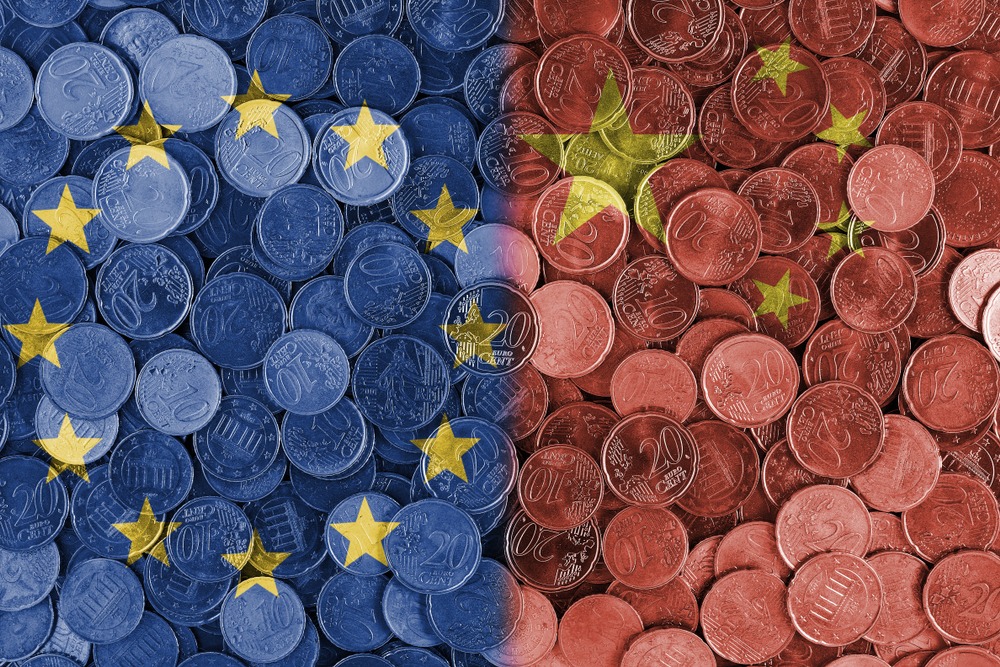
The EU-China Investment Agreement: A win for China?
18 February, 2021
The conclusion of negotiations on the EU-China Comprehensive Agreement on Investment (CAI) has been heralded as both a significant win for the EU and been criticized for threatening transatlantic relations and its tradition of upholding values-based trade. China’s unique and multi-faceted relationship with the EU as a negotiating partner, an economic competitor and a systemic rival are reflected in the nearly insurmountable challenges of establishing such an agreement.
The investment agreement between the EU and China concludes 7 years of negotiations during which foreign direct investment (FDI) between the two parties had exponentially increased. Data from the European Commission indicates that Chinese FDI into Europe amounted to 120 billion euros, and the reciprocal relationship from Europe into China amounting to more – 140 million euros. The manufacturing sector is the primary sector of investment for the EU, particularly important to the German automotive industry. It then comes as no surprise that efforts towards an investment agreement were spearheaded by the German presidency of the EU in the latter half of 2020. As a priority of Merkel’s presidency, the EU and China concluded in principle the negotiations for a Comprehensive Agreement on Investment (CAI) on the 30 December 2020.
What is the Investment Agreement? Towards a level playing field
The EU has signaled the CAI as a significant win in ‘rebalancing’ previous asymmetries in terms of barriers to market access, as well as in-market imbalances. Increased market access for EU businesses into China is a significant step in leveling the playing field between the two parties. Provisions have been made to include increased transparency of subsidies, discipline on state-owned enterprises and rules against forced technology transfers, as well as improving in-market access to standard setting bodies. The CAI binds the liberalization of China’s investments over the last 20 years, in doing so preventing backsliding and developing clarity for EU companies.
Additional values-based wins for the EU can be seen in China’s inaugural concessions on sustainability. For the first time China has committed to sustainability measures, including implementing measures in the Paris Agreement. Corporate Social Responsibility (CSR) is also included in the agreement, as well as a stipulation to not lower environmental or labour standards. China commits to working towards the ratification of fundamental International Labour Organisation (ILO) conventions, with specific commitments on forced labour.
Does it close the gap and level the playing field? No, but the CAI is a significant step and represents an unprecedented commitment from China in values-based trade.
Strategic Implications
Reading thus far, the CAI seems to be an undeniable win for the EU, stabilizing what was previously a lopsided trade relationship. Yet the agreement was clearly important enough for President Xi Jinping to personally step in, begging the question: how does China benefit from this agreement?
From an economic perspective, undoubtedly there are benefits to a more open investment relationship, however, maybe more importantly are the political implications. The conclusion of negotiations on CAI have spillover impacts in that they imply a complicity in the actions of the Chinese government. From human rights violations to unacceptable labour and sustainability issues, China represents a problematic dent in the EU’s tradition of values-based trade. Despite provisions within CAI (ILO conventions, Paris Agreement), critics are skeptical on how they can be enforced. Has the EU set a new precedent, that human rights have no place in trade? Or have they created a ‘leverage to eradicate’ issues like forced labour as Commission President Ursula von der Leyen suggests?
It is possible that critics, me included, are too pessimistic of what these provisions really mean or what CSR can look like in a country like China. The success of these measures, as well as level playing field provisions like transparency and rules against forced technology transfers, are reliant on effective dispute resolution procedures. Currently, such mechanisms are largely based on the good will of both sides. As exhibited in the deterioration of trade relations between China and Australia in the past year, good will is insufficient in the maintenance and implementation of a bilateral agreement.
The CAI also has the potential for geopolitical repercussions for the EU’s transatlantic relationship. The timing of negotiations concluding is significant in sending a message to both China and the US of the EU’s priorities. By pushing through an agreement at the end of 2020, the EU has prioritized strategic autonomy over beginning the relationship with newly elected President Biden on a positive note.
Moving Forward
As it stands, both sides are now working towards finalizing the text agreement and translation before legal review and, finally, approval by the EU Council and European Parliament. Further negotiations are needed on investment protection to replace current Member State bilateral agreements (all Member States except Ireland are currently entered into agreements with China that cover this area). Negotiations on both investment protection and dispute resolution aim to be completed within two years of the signature of the CAI and should be closely watched to ensure the results do not negatively impact the current agreement.
The CAI, while a significant step, appears to have been largely oversold. Improvements are primarily in terms of market access, with other provisions, at least at this stage, surface level achievements. Even the benefits of market access, as indicated in the impact assessments conducted on behalf of the Commission, see improvements for European firms only in a small number of sectors in a small number of Member States. Developments in the automotive industry, while most substantial, positively impact larger enterprises rather than small and medium (SMEs), with the potential for far-reaching policy implications for the European automotive industry. It is important to note what was not achieved in this agreement: full reciprocity, procurement and competitive neutrality. In the scramble to conclude negotiations in 2020, both Member States and the public were denied a robust public defense and justification of the CAI, which is no doubt needed when European values are at stake.